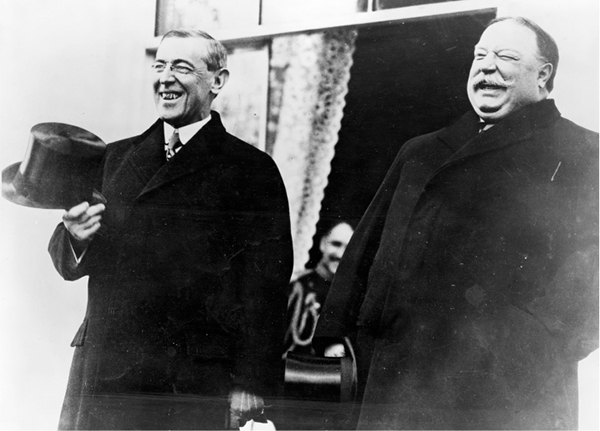Woodrow Wilson and the New Freedom Agenda
Once in office, Wilson hurried to fulfill his New Freedom agenda. Even though he differed from Roosevelt about the scope of federal intervention, both men believed in a strong presidency. An admirer of the British parliamentary system, Wilson viewed the president as an active and strong leader whose job was to provide his party with a legislative program. The 1912 elections had given the Democrats control over Congress, and Wilson expected his party to support his New Freedom measures.

Tariff reduction came first. The Underwood Act of 1913 reduced import duties, a measure that appealed to southern and midwestern farmers who sought lower prices on the manufactured goods they bought that were subject to the tariff. The law also incorporated a reform that progressives had adopted from the Populists: the graduated income tax (tax rates that increase at higher levels of income). The ratification of the Sixteenth Amendment in 1913 provided the legal basis for the income tax after the Supreme Court had previously declared such a levy unconstitutional. The graduated income tax was meant to advance the cause of social justice by moderating income inequality. The need to recover revenues lost from lower tariffs provided an additional practical impetus for imposing the tax. Because the law exempted people earning less than $4,000 a year from paying the income tax, more than 90 percent of Americans owed no tax. Those with incomes exceeding this amount paid rates ranging from 1 percent to 6 percent on $500,000 or more.
Also in 1913, Wilson pressed Congress to consider banking reform. Farmers favored a system supervised by the government that afforded them an ample supply of credit at low interest rates. Eastern bankers wanted reforms that would stabilize a system plagued by cyclical financial panics, the most recent in 1907, while keeping the banking system under the private control of bankers. The resulting compromise created the Federal Reserve System. The act established twelve regional banks. These banks lent cash reserves to member banks in their districts at a “rediscount rate,” a rate that could be adjusted according to the fluctuating demand for credit. Federal Reserve notes became the foundation for a uniform currency. The Federal Reserve Board, appointed by the president and headquartered in Washington, D.C., supervised the system. Nevertheless, as with other progressive agencies, the experts selected to oversee the new banking system came from within the banking industry itself. Although farmers won a more rational and flexible credit supply, Wall Street bankers retained considerable power over the operation of the Federal Reserve System.
Next, President Wilson took two steps designed to help resolve the problem of economic concentration. First, in 1914 he persuaded Congress to create the Federal Trade Commission. The commission had the power to investigate corporate activities and prohibit “unfair” practices (which the law left undefined). Wilson’s second measure directly attacked monopolies. Enacted in 1914, the Clayton Antitrust Act strengthened the Sherman Antitrust Act by banning certain corporate operations, such as price discrimination and overlapping membership on company boards, which undermined economic competition. The statute also exempted labor unions from prosecution under antitrust legislation, reversing the policy initiated by the federal government in the wake of the Pullman strike.
By the end of his second year in office, Wilson had achieved most of his New Freedom objectives. Political considerations, however, soon forced him to widen his progressive agenda and support measures he had previously rejected. With the Republican Party once again united after the electoral fiasco of 1912, Wilson, looking ahead to reelection in 1916, resumed the campaign for progressive legislation. Wilson appealed to Roosevelt’s constituency by supporting New Nationalism social justice measures. In 1916 he signed into law the Adamson Act, which provided an eight-hour workday and overtime pay for railroad workers; the Keating-Owen Act, outlawing child labor in firms that engaged in interstate commerce; and the Workmen’s Compensation Act, which provided insurance for federal employees in case of injury. In supporting programs that required greater intervention by the federal government, Wilson had placed political expediency ahead of his professed principles. He would later show a similar flexibility when he lent his support to a women’s suffrage amendment, a cause he had long opposed.
Despite facing a challenge from a united Republican Party, Wilson won the 1916 election against former New York Governor Charles Evans Hughes with slightly less than 50 percent of the vote. Wilson’s reelection owed little to support from African Americans. W. E. B. Du Bois, who backed Wilson in 1912 for pledging to “assist in advancing the interest of [the black] race,” had become disillusioned with the president. Born in the South and with deep southern roots, Wilson surrounded himself with white appointees from the South. Despite black protests, Wilson held a screening in the White House of the film Birth of a Nation, which glorified the Ku Klux Klan and denigrated African Americans. Making the situation worse, Wilson introduced racial segregation into government offices and dining facilities in the nation’s capital, and blacks lost jobs in post offices and other federal agencies throughout the South. In Wilson’s view, segregation and discrimination were in the “best interests” of African Americans.
Still, President Wilson achieved much of the progressive agenda—more, in fact, than he had intended to when he first came to office. By the beginning of his second term, the federal government had further extended regulation over the activities of corporations and banks. Big business and finance still wielded substantial power, but Wilson had steered the government on a course that also benefited ordinary citizens, including passage of social justice measures he had originally opposed.
REVIEW & RELATE
How did the progressive agenda shape presidential politics in the first two decades of the twentieth century?
How and why did the role of the president in national politics change under Roosevelt, Taft, and Wilson?
Exploring American HistoriesPrinted Page 640
Exploring American Histories Value EditionPrinted Page 473
Chapter Timeline